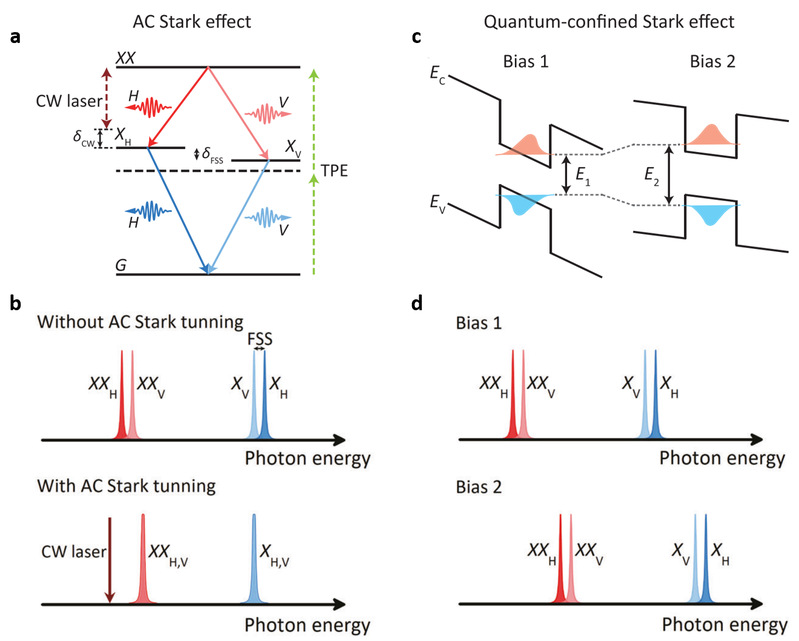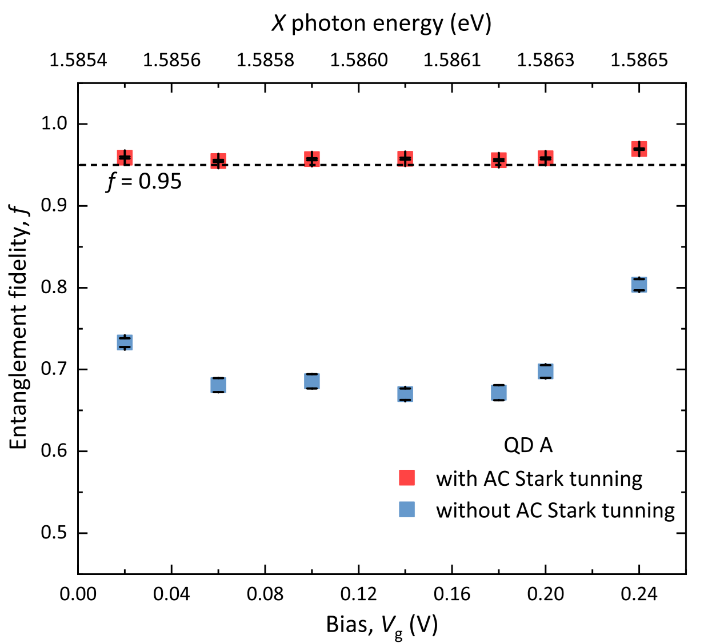A study led by LIU Feng from the College of Information Science and Electronic Engineering at Zhejiang University, titled “Wavelength-tunable high-fidelity entangled photon sources enabled by dual Stark effects,” has recently been published in Nature Communications.

Background
Developing large-scale quantum networks requires quantum repeaters composed of multiple entangled photon sources with the same emission wavelength. Semiconductor quantum dots (QDs) can generate entangled photon pairs deterministically with high fidelity. However, quantum repeater systems based on quantum dots face two main challenges: the non-uniformity of emission wavelength and exciton fine-structure splitting (FSS) induced fidelity reduction. While QDs have demonstrated the ability to generate high-fidelity polarization-entangled photons and allow wavelength tuning via electric fields, magnetic fields or stress, achieving both large wavelength tuning and high fidelity simultaneously remains a challenge.
Research Highlights
Hybrid Tuning Scheme Combining AC Stark Effect and Quantum-Confined Stark Effect.
The research team proposed a hybrid tuning scheme combining the AC Stark effect and the quantum-confined Stark effect (QCSE). They applied a DC electric field to tune the fluorescence wavelength via QCSE (Fig. 1 c, d) and used a detuned laser to eliminate FSS through the AC Stark effect (Fig. 1 a, b).

Fig. 1. Schematic diagram of the hybrid tuning scheme. a-b. Schematic of FSS tuning via the AC Stark effect. c-d. Schematic of emission wavelength tuning via the QCSE.
In the experiment, the team measured the fluorescence spectrum of a single quantum dot under different biases using two-photon excitation (TPE), demonstrating the exciton wavelength tuning range of approximately 1 mV (around 190 times the emission linewidth). They also eliminated fine structure splitting at various emission wavelengths (Fig. 2). Based on this hybrid tuning scheme, the team achieved a polarization entanglement fidelity greater than 0.955 across the entire exciton wavelength tuning range (Fig. 3).

Fig. 2. Simultaneous tuning of wavelength and fine-structure splitting. a. Bias-dependent fluorescence spectra of a single QD under TPE. b Fine structure splitting of the QD. c-h. Elimination of fine structure splitting at different wavelengths.

Fig. 3. Entanglement fidelity at different wavelengths.
High-performance Quantum Dot Entangled Photon Sources (EPS) with Multi-Wavelength Matching
After maintaining high entanglement fidelity across the entire tuning range, the team further demonstrated the resonance tuning of multiple quantum dot sources with high entanglement fidelity (Fig. 4a-b, with fidelities of 0.958(1), 0.928(2), and 0.947(2) for three QDs). This is a key foundation for QD-based quantum repeaters and quantum teleportation. Additionally, the team demonstrated a quantum dot entangled photon source resonant with the rubidium atom transition (85Rb), achieving a fidelity of 0.919(3) (Fig. 4c-d) — an essential step for quantum dot–rubidium atom quantum memory interfaces.

Fig. 4. Multiple wavelength-matched QD EPSs. a. Three QDs with the same exciton wavelength. b. Entanglement fidelity of different QDs. c. Saturation absorption spectrum of rubidium atoms at room temperature. d. Two-photon resonance fluorescence spectrum of QD resonant with rubidium atoms.
Conclusion
This groundbreaking study represents a significant advancement in the integration of multiple quantum dot entangled photon sources for large-scale quantum network construction. The dual tuning capability for fine structure splitting and emission wavelength, as demonstrated in this study, highlights the potential of QD technology in quantum network development.
The research was a collaborative effort among CHEN Chen and YAN Junyong, the lead authors, under the guidance of Researcher LIU Feng, with contributions from several national and international institutions. This work received support from the National Key Research and Development Program and the National Natural Science Foundation of China.
